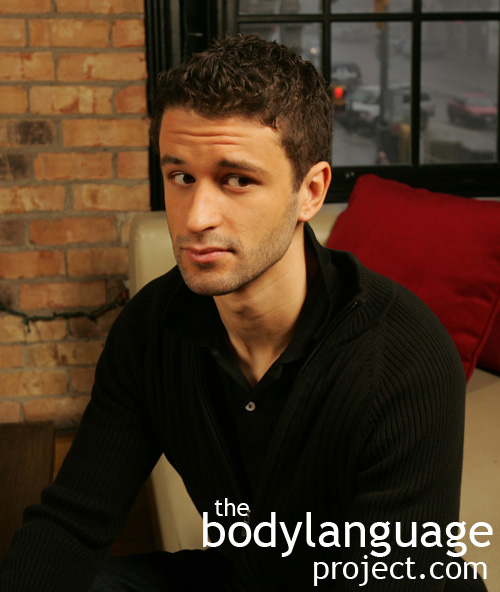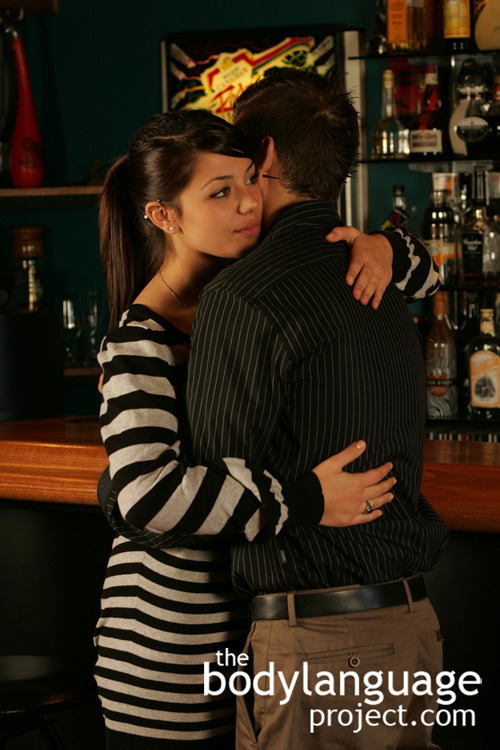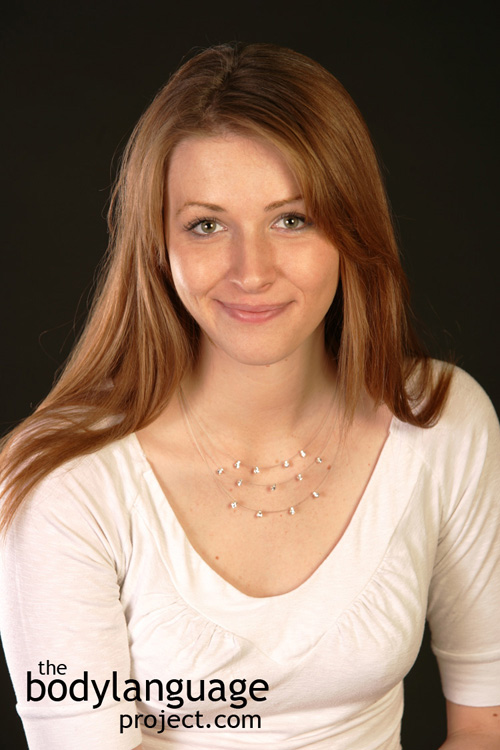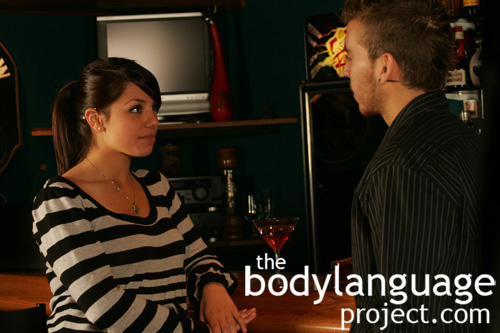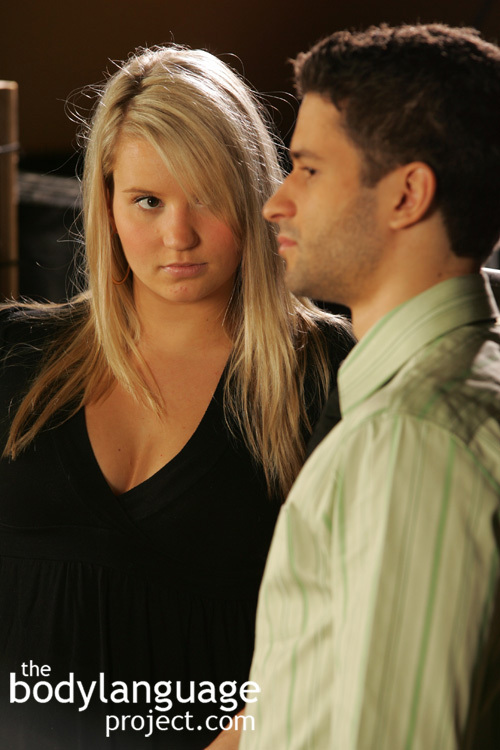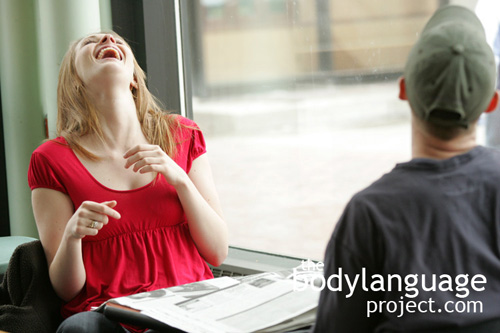Body Language of Gait or Walking Styles
Synonym(s): Walking Styles.
Description: Refers to the style or mechanics of locomotion in humans and its hidden meaning.
In One Sentence: Gait is highly unique to each person much like a fingerprint and it’s style is connected to various personality traits.
How To Use it: Use your gait to signal desired qualities to others. A bouncy gait signals joy and happiness, a swagger shows sexual energy, hobble shows age, darting shows impatience, prancing shows femininity. Use the type of gait that suits your personality best.
Context: General
Verbal Translation: “How I walk gives clues to my health, emotions, character and accomplishments.”
Variant: N/A
Cue In Action: He just won the lottery. Not only did he carry a huge grin on his face, but he also walked with an exaggerated bounce in his step. It was as if he had been transported back to his youth.
Meaning and/or Motivation: Scientists have identified thirty six different types of gait in the human species. They include the hobble, the mince, the glide, the bounce, the stride, the wiggle, the dart, the prance and the run. People can shuffle along or drag their feet, bounce up and down, or seem to float on air.
How one walks gives clues to the internal workings of people, their emotions and rhythm, character and even their accomplishments not to mention their health and age.
Those who are positive will tend to walk energetically while those who are down and depressed or elderly will saunter or hobble about. The effect is particularly pronounced between the old and young, but it can easily be seen between those who expect good things to happen and those who do not.
Cue Cluster: Watch for additional cues coupled with gait types to decide the overall mental attitude and disposition people carry.
Body Language Category: Amplifier, Confident body language, Depressive body language, Emotional body language, Enthusiasm (nonverbal), Excited body language, Gravity defying body language, Happiness, High confidence body language, Low confidence body language.
Resources:
Angela Book, Kimberly Costello and Joseph A. Camilleri Psychopathy and Victim Selection: The Use of Gait as a Cue to Vulnerability. Journal of Interpersonal Violence. 2013. 28(11): 2368-2383. DOI: 10.1177/0886260512475315jiv.sagepub.com
http://bodylanguageproject.com/articles/dont-walk-like-youre-watched-avoid-victimization-nonverbal-behavior/
Brownlow, S., Dixon, A. R., Egbert, C. A., & Radcliffe, R. D. (1997). Perception of movement and dancer characteristics from point-light displays of dance. The sychological Record, 47(3), 411–421. http://dx.doi.org/10.1068/p250727.
Crane, Elizabeth ; Gross, M. Effort-Shape Characteristics of Emotion-Related Body Movement. Journal of Nonverbal Behavior. 2013. 37(2): 91-105.
Cutting, J. E., & Kozlowski, L. T. (1977). Recognizing friends by their walk: Gait perception without familiarity cues. Bulletin of the Psychonomic Society, 9(5), 353–356.
Cho, S. H., Park, J. M., & Kwon, O. Y. (2004). Gender differences in three dimensional gait analysis data from 98 healthy Korean adults. Clinical Biomechanics, 19, 145–152.
Cutting, J. E., & Kozlowski, L. T. (1977). Recognizing friends by their walk: Gait
perception without familiarity cues. Bulletin of the Psychonomic Society, 9, 353–356.
Eisenberg, Philip ; Reichline, Philipb. Judging Expressive Movement: II. Judgments of Dominance-Feeling from Motion Pictures of Gait. The Journal of Social Psychology. 1939. 10(3): 345-357.
Fink, Bernhard; Nadine Hugill and Benjamin P. Lange. Women’s Body Movements Are a Potential Cue to Ovulation. Personality and Individual Differences. 2012. 53: 759-763.
http://bodylanguageproject.com/articles/women-use-sexier-body-language-indicate-ovulation-fertility-women-dance-walk-sexier/
Gunns, Rebekah E; Lucy Johnston; and Stephen M. Hudson. Victim Selection And Kinematics: A Point-Light Investigation Of Vulnerability To Attack. Journal of Nonverbal Behavior. 2002. 26(3): 129-158.
http://bodylanguageproject.com/articles/how-to-avoid-an-attack-just-by-changing-how-you-walk-study/
Guéguen N. Gait and menstrual cycle: ovulating women use sexier gaits and walk slowly ahead of men. Gait Posture. 2012; 35(4): 621-4.
http://bodylanguageproject.com/articles/gait-as-bait-women-walk-sexy-during-high-sexual-receptivity/
Gross, M Melissa ; Crane, Elizabeth A ; Fredrickson, Barbara L. Effort-Shape and kinematic assessment of bodily expression of emotion during gait. Human movement science. 2012. 31(1): 202-21.
Hasegawa, T. and K. Sakaguchi. 2006. Person perception through gait information and target choice for sexual advances: comparison of likely targets in experiments and real life. Journal of Nonverbal Behavior 30(2): 63-85.
Johnson, Kerri L.; Gill, Simone; Reichman, Victoria and Tassinary, Louis G. Swagger, Sway, and Sexuality: Judging Sexual Orientation from Body Motion and Morphology. Journal of Personality and Social Psychology. 2007. 93(3): 321-334. doi: 10.1037/0022-3514.93.3.321
http://bodylanguageproject.com/articles/heterosexual-vs-homosexual-swagger-can-you-spot-the-difference/
Janssen, Daniel ; Schöllhorn, Wolfgang ; Lubienetzki, Jessica ; Fölling, Karina ; Kokenge, Henrike ; Davids, Keith. Recognition of Emotions in Gait Patterns by Means of Artificial Neural Nets. Journal of Nonverbal Behavior. 2008. 32(2): 79-92.
Johnson, Kerri L ; Gill, Simone ; Reichman, Victoria ; Tassinary, Louis G. Swagger, sway, and sexuality: Judging sexual orientation from body motion and morphology. Journal of personality and social psychology. 2007. 93(3): 321-34.
Johnson, Kerri L ; Tassinary, Louis G. Perceiving sex directly and indirectly: meaning in motion and morphology. Psychological science. 2005. 16(11): 890-7.
Kito, Tomonori ; Yoneda, Tsugutake. Dominance of gait cycle duration in casual walking. Human Movement Science. 2006. 25(3): 383-392.
Kozlowski, L. T., & Cutting, J. E. (1977). Recognizing the sex of a walker from a dynamic point-light display. Perception and Psychophysics, 21(6), 575–580.
Montepare, Joann ; Zebrowitz, Leslie. A cross-cultural comparison of impressions created by age-related variations in gait. Journal of Nonverbal Behavior. 1993. 17(1): 55-68.
Montepare, Joann ; Goldstein, Sabra ; Clausen, Annmarie. The identification of emotions from gait information. Journal of Nonverbal Behavior. 1987. 11(1): 33-42.
Montepare, J. M., & Zebrowitz-McArthur, L. (1988). Impressions of people created by age-related qualities of their gaits. Journal of Personality and Social Psychology, 55(4), 547–556. http://dx.doi.org/10.1037/ 0022-3514.55.4.547.
Miller, G., Tybur, J. M., & Jordan, B. D. Ovulatory cycle effects on tip earning by lap dancers: Economic evidence for human estrus. Evolution and Human Behavior. 2007. 28: 375-381. http://dx.doi.org/10.1016/j.evolhumbehav.2007.06.002.
Montepare, J. M., Goldstien, S. B., & Clausen, A. (1987). The identification of emotions from gait information. Journal of Nonverbal Behavior, 11, 33–42.
Michalak, J., Rohde, K., Troje, N. F. How We Walk Affects What We Remember: Gait Modifications Through Biofeedback Change Negative Affective Memory Bias. Journal of Behavior Therapy and Experimental Psychiatry. 2015. 46:121-125.
http://bodylanguageproject.com/articles/walking-happy-leads-actual-happiness-game-emotions-body-language/
Moore, Monica. Courtship Signaling and Adolescents: Girls Just Wanna Have Fun. Journal of Sex Research. 1995. 32(4): 319-328.
http://bodylanguageproject.com/articles/girls-just-want-to-have-fun-the-origins-of-courtship-cues-in-girls-and-women/
Opila-Correia, K. A. (1990). Kinematics of high-heeled gait. Archives of Physical Medicine and Rehabilitation, 71, 304–309.
Prasad, S., & Shiffrar, M. (2009). Viewpoint and the recognition of people from their movements. Journal of Experimental Psychology – Human Perception and Performance, 35(1), 39–49. http://dx.doi.org/10.1037/A0012728.
Roether, C. L., Omlor, L., Christensen, A., & Giese, M. A. (2009). Critical features for the perception of emotion from gait. Journal of Vision, 9(6), 1–32. http://dx.doi.org/10.1167/9.6.15.
Sakaguchi, Kikue and Toshikazu Hasegawa. Person Perception Through Gait Information And Target Choice For Sexual Advances: Comparison Of Likely Targets In Experiments And Real Life. Journal of Nonverbal Behavior. 2006; 30:63-85. DOI 10.1007/s10919-006-0006-2
http://bodylanguageproject.com/articles/dont-walk-like-youre-asking-targets-sexual-approach-based-walking-style-personality-study/
Schneider, Sabrina ; Christensen, Andrea ; Hau[sz]inger, Florian B. ; Fallgatter, Andreas J. ; Giese, Martin A. ; Ehlis, Ann – Christine. Show me how you walk and I tell you how you feel — A functional near-infrared spectroscopy study on emotion perception based on human gait. Neuroimage. 2014. 85: 380(11).
Smith, E. O. (1999). High heels and evolution: Natural selection, sexual selection and high heels. Psychology, Evolution and Gender, 30, 245–277. Smith, E. O., & Helms, W. S. (1999). Natural selection and high heels. Foot and Ankle International, 20, 55–57.
Thoresen, John C.; Quoc C. Vuong and Anthony P. Atkinson. First Impressions: Gait Cues Drive Reliable Trait Judgements. Cognition. 2012. 261–271 Thoresen, John C.; Quoc C. Vuong and Anthony P. Atkinson. First Impressions: Gait Cues Drive Reliable Trait Judgements. Cognition. 2012. 261–271
http://bodylanguageproject.com/articles/walk-drives-first-impressions/
van der Zwan, Rick and Natasha Herbert. “I Like The Way You Move”: How Hormonal Changes Across The Menstrual Cycle Affect Female Perceptions of Gait. Research Notes. 2012; 5: 453.
http://bodylanguageproject.com/articles/women-at-peak-fertility-rate-other-female-walkers-less-favorably/
Walter, K. D., Brownlow, S., Ervin, S. L., & Williamson, N. (1998). Something in the way she moves: The influence of shoe altered gait on motion and trait impressions of women. PSI CHI Journal of Undergraduate Research, 3, 163–169.


